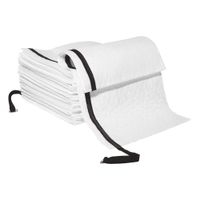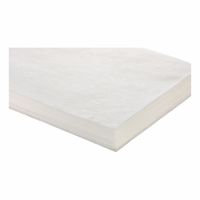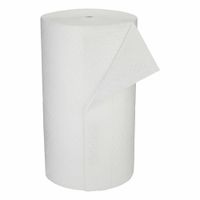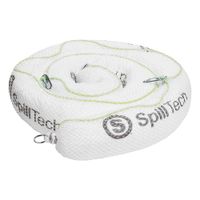Call +(254) 703 030 000 / 751 483 999 / 721 704 777
- Home
- Safety
- Sorbents Spill Control Spill Containment
- Sorbents Spill Kits
- Oil Only Sorbents Spill Kits
.....Read More
Frequently Asked Questions
What are oil-only sorbents and how do they work?
Oil-only sorbents are materials specifically designed to absorb oil and other hydrocarbon-based liquids while repelling water. They are used in spill response and environmental cleanup to manage oil spills on water bodies or land. These sorbents are typically made from hydrophobic and oleophilic materials, meaning they repel water and attract oil.
The primary materials used in oil-only sorbents include polypropylene, polyester, and other synthetic fibers. These materials are often treated or manufactured in a way that enhances their oil-attracting properties. The structure of these sorbents can vary, including pads, rolls, booms, pillows, and loose particulate forms, each suited for different spill scenarios.
Oil-only sorbents work through a process called adsorption, where oil molecules adhere to the surface of the sorbent material. The oleophilic nature of the sorbent ensures that oil is preferentially absorbed over water, making them effective even in marine environments. When deployed, these sorbents float on water, allowing them to remain effective in absorbing oil without becoming waterlogged.
The effectiveness of oil-only sorbents depends on factors such as the type of oil, the temperature, and the environmental conditions. Once saturated, the sorbents can be removed and disposed of according to environmental regulations. Some sorbents can be wrung out and reused, while others are designed for single use.
Overall, oil-only sorbents are a crucial tool in environmental protection, providing an efficient and targeted method for managing oil spills and minimizing ecological damage.
What is included in an oil-only spill kit?
An oil-only spill kit typically includes the following components:
1. **Absorbent Pads**: These are designed to absorb oil while repelling water. They are used to soak up oil spills on land or water surfaces.
2. **Absorbent Socks/Booms**: These are long, tubular absorbents that can be placed around the spill to contain and prevent it from spreading. They are particularly useful for surrounding the perimeter of a spill.
3. **Absorbent Pillows**: These are used for larger spills or in areas where a pad or sock might not be sufficient. They can absorb a significant amount of oil.
4. **Disposal Bags and Ties**: These are used to safely dispose of used absorbents and other contaminated materials. They are typically heavy-duty and labeled for hazardous waste.
5. **Protective Gloves**: These are included to protect the user from direct contact with the oil and any hazardous substances.
6. **Safety Goggles**: These protect the eyes from splashes and fumes during the cleanup process.
7. **Instruction Manual**: A guide on how to effectively use the spill kit components and safely manage the spill.
8. **Personal Protective Equipment (PPE)**: Depending on the kit, additional PPE such as coveralls or masks may be included for added safety.
9. **Container**: The kit is usually housed in a durable, portable container or bag that is easy to transport to the spill site.
These components are specifically designed to handle oil-based spills, ensuring that they do not absorb water, making them ideal for marine and industrial environments where oil spills are a concern.
How do oil-only sorbent pads differ from other types of sorbents?
Oil-only sorbent pads are specifically designed to absorb oil-based liquids while repelling water. This makes them ideal for situations where oil needs to be removed from water surfaces, such as in marine oil spills or industrial settings where oil and water are present together. They are typically made from hydrophobic materials like polypropylene, which allows them to float on water and selectively absorb oil.
In contrast, universal sorbents are designed to absorb a wide range of liquids, including oils, water, coolants, and solvents. They are made from materials that do not discriminate between oil and water, making them versatile for general spill management but less effective in separating oil from water.
Chemical sorbents, another type, are specifically formulated to handle hazardous chemical spills. They are made from materials that can neutralize or contain specific chemicals, making them unsuitable for oil-only applications.
The key difference lies in the material composition and intended use. Oil-only sorbents are hydrophobic and oleophilic, meaning they repel water and attract oil, while universal sorbents are hydrophilic and absorb both oil and water. Chemical sorbents are specialized for chemical containment and may not be effective for oil or water.
In summary, oil-only sorbent pads are specialized tools for oil spill management, offering targeted absorption of oil while repelling water, unlike universal or chemical sorbents, which are designed for broader or different applications.
How should oil-only sorbents be disposed of after use?
Oil-only sorbents should be disposed of according to local, state, and federal regulations, as they are considered hazardous waste once they have absorbed oil. The general steps for disposal are as follows:
1. **Segregation**: Separate used oil-only sorbents from other types of waste to prevent contamination and ensure proper disposal.
2. **Containment**: Place the used sorbents in appropriate containers, such as sealed, labeled drums or bags, to prevent leaks and spills during storage and transportation.
3. **Labeling**: Clearly label the containers with information indicating that they contain used oil sorbents, including the type of oil absorbed and the date of collection.
4. **Storage**: Store the containers in a designated hazardous waste storage area, ensuring they are kept away from sources of ignition and are protected from the elements.
5. **Transportation**: Arrange for transportation by a licensed hazardous waste hauler. Ensure that the hauler complies with all relevant regulations for transporting hazardous materials.
6. **Disposal**: Dispose of the sorbents at a licensed hazardous waste treatment, storage, and disposal facility (TSDF). Options may include incineration, which can recover energy from the waste, or other approved methods that comply with environmental regulations.
7. **Documentation**: Maintain records of the disposal process, including waste manifests, to ensure compliance with regulatory requirements and to provide an audit trail.
8. **Recycling**: In some cases, oil can be extracted from the sorbents for recycling. Check with local facilities to see if this option is available and complies with regulations.
Always consult with environmental health and safety professionals or regulatory agencies to ensure compliance with specific legal requirements in your area.
Can oil-only sorbents be reused or recycled?
Oil-only sorbents can be reused or recycled, but the feasibility depends on several factors, including the type of sorbent material, the extent of contamination, and the specific recycling or reuse processes available.
Reusable sorbents, such as certain synthetic pads or booms, can be wrung out and reused multiple times until they reach their saturation point. This process involves mechanically squeezing out the absorbed oil, which can then be collected and processed. However, the effectiveness of reuse diminishes over time as the sorbent material may degrade or lose its absorbency.
Recycling oil-only sorbents is possible through specialized processes. Some facilities can clean and regenerate sorbents by removing the absorbed oil, which can then be refined or repurposed. The cleaned sorbents can be reused, reducing waste and the need for new materials. However, this process requires specific infrastructure and may not be available everywhere.
In some cases, incineration is used as a disposal method for oil-soaked sorbents, where the energy content of the absorbed oil is recovered. This is not recycling in the traditional sense but can be considered a form of energy recovery.
Ultimately, the decision to reuse or recycle oil-only sorbents depends on economic, environmental, and logistical considerations. Proper handling and disposal are crucial to prevent environmental contamination and adhere to regulations.
What are the advantages of using oil-only sorbents over other types?
Oil-only sorbents offer several advantages over other types of sorbents:
1. **Selective Absorption**: Oil-only sorbents are hydrophobic and oleophilic, meaning they repel water while attracting and absorbing oil. This makes them ideal for oil spill scenarios where water is present, as they will not become saturated with water, allowing them to absorb more oil.
2. **Efficiency**: Due to their selective nature, oil-only sorbents can absorb a large volume of oil relative to their weight. This efficiency reduces the amount of sorbent material needed, lowering costs and minimizing waste.
3. **Versatility**: These sorbents are available in various forms, such as pads, rolls, booms, and pillows, making them adaptable to different spill situations, whether on land or water.
4. **Ease of Use**: Oil-only sorbents are easy to deploy and retrieve, which is crucial during emergency spill responses. Their lightweight nature also facilitates handling and transportation.
5. **Environmental Impact**: By effectively containing and removing oil from the environment, oil-only sorbents help mitigate the ecological damage caused by oil spills. Some are made from biodegradable materials, further reducing environmental impact.
6. **Cost-Effectiveness**: The high absorption capacity and reduced need for additional materials make oil-only sorbents a cost-effective solution for managing oil spills.
7. **Regulatory Compliance**: Using oil-only sorbents can help organizations comply with environmental regulations by efficiently managing oil spills and minimizing environmental harm.
8. **Reusability**: Some oil-only sorbents can be wrung out and reused, which can further reduce costs and waste.
Overall, oil-only sorbents provide a targeted, efficient, and environmentally friendly solution for managing oil spills, particularly in aquatic environments.
How do oil-eating microbes contribute to oil spill cleanup?
Oil-eating microbes, also known as hydrocarbon-degrading bacteria, play a crucial role in the bioremediation of oil spills. These microorganisms naturally occur in marine and terrestrial environments and have evolved the ability to use hydrocarbons, the primary components of oil, as a source of energy and carbon. When an oil spill occurs, these microbes can be stimulated to increase in number and activity, thereby accelerating the breakdown of oil.
The process begins with the microbes attaching to oil droplets. They secrete enzymes that break down complex hydrocarbons into simpler compounds. These enzymes, such as oxygenases and dehydrogenases, initiate the degradation process by adding oxygen to the hydrocarbon molecules, making them more soluble and easier to digest. The microbes then metabolize these simpler compounds, converting them into carbon dioxide, water, and biomass, which are less harmful to the environment.
Environmental factors such as temperature, oxygen availability, and nutrient levels (particularly nitrogen and phosphorus) influence the efficiency of microbial degradation. In some cases, bioremediation strategies involve adding nutrients or dispersants to enhance microbial activity and oil dispersion, respectively.
The use of oil-eating microbes is considered an environmentally friendly and cost-effective method for oil spill cleanup. Unlike physical or chemical methods, bioremediation minimizes the impact on ecosystems and can be applied over large areas. However, the process can be slow and is not suitable for all types of oil or environmental conditions. Therefore, it is often used in conjunction with other cleanup methods to achieve optimal results.







